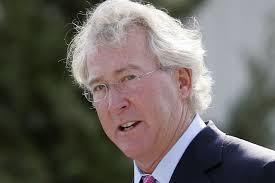
The question of whether shale pioneer Aubrey McClendon drove his car deliberately into a wall may never be answered, the Oklahoma City police said Monday.
The latest clues came when the police department released its final crash report, showing that on March 2 McClendon made no serious attempt to slow his SUV as it veered across the road and smashed into a concrete wall at 78 miles per hour, bursting into flames and killing him.
Investigators are now focusing on the final hours of McClendon’s life in hopes of saying with more certainty whether or not he intended to kill himself on a small country road the morning after being indicted. While the car appears to have been working normally, until the toxicology report is complete the medical examiner can’t rule out whether a physical problem may have affected McClendon.
The Chesapeake Energy Corp. co-founder’s 2013 Chevy Tahoe crashed the morning after a federal grand jury indicted him on bid-rigging charges. Police are also attempting to recover McClendon’s mobile phone records to determine if he was using it while in the car or what he might have said. Investigators will give their results to the medical examiner for its final manner- of-death ruling, Chief Bill Citty told reporters Monday.
“A lot of people want to jump to the conclusion that it was suicide,” Capt. Paco Balderrama said Monday in a phone interview. “We are going to do the best we can in order to try to determine what happened, but we may never find out why it happened.”
‘Tapped Brakes’
McClendon, 56, didn’t act “assertively” to slow the vehicle in the last 31 feet (9.4 meters) before the crash, police said. The SUV crossed the road’s center line 189 feet before hitting the wall, maintaining a speed of 88 miles per hour even as he lightly tapped the brakes several times. It slowed to 78 mph at impact, possibly because it hit softer ground after leaving the roadway, the police said.
The county medical examiner has said McClendon died from wounds caused by multiple blunt force trauma. Results of a toxicology report have not yet been released.
“In general, most life insurance policies have either a one-year or two-year suicide exclusion clause that states that if a person commits suicide within that time frame, their premiums are returned back to them, but not the death benefit,” Iowa Insurance Commissioner Nick Gerhart, who leads the National Association of Insurance Commissioners’ life insurance and annuities committee, said this month in an e-mailed statement.
Investigation Continuing
“We have investigators that are going to be talking to people to try and put the pieces together from maybe the night before until the time this happened to find out if there would be any reason that he decided to take his own life,” Citty said Monday on a webcast from KFOR-TV in Oklahoma City.
The crash info is based on an examination of the SUV’s data recorder, which showed what the vehicle was doing up to five seconds before impact, Citty said. The head-on collision with the concrete wall caused the Tahoe to rotate counter-clockwise as it bounced back and came to rest 7 feet from the point of impact, according to the completed crash report police released Monday.
The day before the crash, a federal grand jury charged McClendon in connection with a scheme between two “large oil and gas companies” to avoid bidding against each other for leases in northwest Oklahoma from December 2007 to March 2012. In a statement hours after the indictment was announced, McClendon called the charge “wrong and unprecedented.”
Shale Champion
McClendon co-founded Chesapeake, expanding it from modest beginnings into the second-largest U.S. natural gas producer, thanks to his championing of hydraulic fracturing and horizontal drilling at a time when larger, more established players were skeptical of shale’s potential. At its height in June 2008, Chesapeake was valued at $37.5 billion.
Tumbling gas prices from an oversupply of the heating and power plant fuel ultimately led to McClendon’s ouster from Chesapeake in 2013, after the company’s value fell by more than half. He then formed American Energy Partners LP, and raised more than $10 billion for acquisitions.
The crash occurred in a rural area about 20 minutes northeast of his offices in Oklahoma City. The country road McClendon sped down offered limited room for maneuvering, with thick, bushy trees on both side and no shoulder on the road. An initial police report of the crash said McClendon was not wearing his seat belt while traveling at a high rate of speed. The listed speed limit was 50 miles an hour.
Police said last week they were working on a computer reanimation of the accident and were rechecking and confirming all data and calculations for the completed accident report and planned to release it early this week.